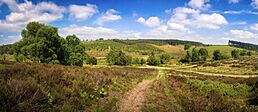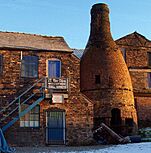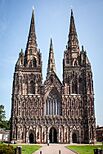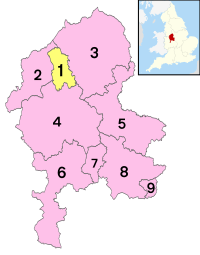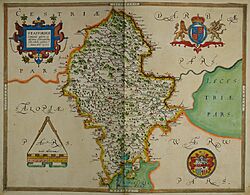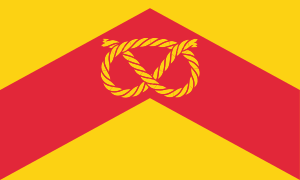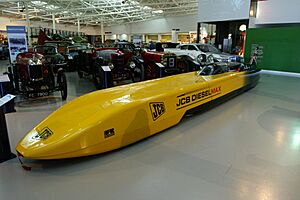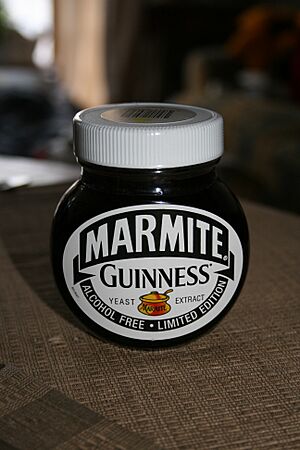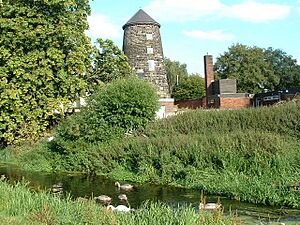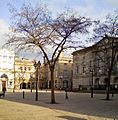Staffordshire facts for kids
Quick facts for kids
Staffordshire
|
|||||||||||||||||||||||||||||||||||||||||||||||||||||||
|---|---|---|---|---|---|---|---|---|---|---|---|---|---|---|---|---|---|---|---|---|---|---|---|---|---|---|---|---|---|---|---|---|---|---|---|---|---|---|---|---|---|---|---|---|---|---|---|---|---|---|---|---|---|---|---|
|
The Sherbrook Valley in Cannock Chase; a bottle kiln in Longton, Stoke-on-Trent; and Lichfield Cathedral
|
|||||||||||||||||||||||||||||||||||||||||||||||||||||||
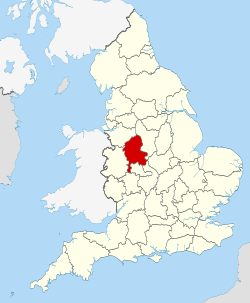 Staffordshire within England Staffordshire within England |
|||||||||||||||||||||||||||||||||||||||||||||||||||||||
| Sovereign state | United Kingdom | ||||||||||||||||||||||||||||||||||||||||||||||||||||||
| Constituent country | England | ||||||||||||||||||||||||||||||||||||||||||||||||||||||
| Region | West Midlands | ||||||||||||||||||||||||||||||||||||||||||||||||||||||
| Established | Ancient | ||||||||||||||||||||||||||||||||||||||||||||||||||||||
| Time zone | UTC±00:00 (Greenwich Mean Time) | ||||||||||||||||||||||||||||||||||||||||||||||||||||||
| • Summer (DST) | UTC+01:00 (British Summer Time) | ||||||||||||||||||||||||||||||||||||||||||||||||||||||
| Members of Parliament | List of MPs | ||||||||||||||||||||||||||||||||||||||||||||||||||||||
| Police | Staffordshire Police | ||||||||||||||||||||||||||||||||||||||||||||||||||||||
|
|||||||||||||||||||||||||||||||||||||||||||||||||||||||
Staffordshire (often called Staffs.) is a county in the West Midlands of England. It is a "landlocked" county, meaning it has no coast. Staffordshire shares borders with several other counties. These include Cheshire to the north-west and Derbyshire and Leicestershire to the east. To the south-east, it borders Warwickshire, and to the south, it borders the West Midlands county and Worcestershire. Finally, it borders Shropshire to the west.
The largest city in Staffordshire is Stoke-on-Trent. The main town, which is the county town, is Stafford. The county covers about 2,713 square kilometers and has over 1.1 million people. Besides Stoke-on-Trent, other large towns include Tamworth, Newcastle-under-Lyme, and Burton upon Trent.
Staffordshire has varied landscapes. The northern and southern parts are hilly. The northern area includes part of the Peak District National Park. In the south, you'll find Cannock Chase, a beautiful natural area. The River Trent flows through most of the county.
This area has a long history. People lived here in the Iron Age and during Roman times. The Angles settled here in the 6th century. Staffordshire became a county in the early 10th century, with Stafford as its capital. During the Industrial Revolution, the county grew quickly. It became famous for its pottery, which is still made in Stoke-on-Trent today.
Contents
History of Staffordshire
Staffordshire has a rich history. Long ago, it was divided into five main areas called "hundreds." These were Cuttlestone, Offlow, Pirehill, Seisdon, and Totmonslow.
The county's borders have changed over time. In 1889, a new administrative county was created. Some towns like Wolverhampton and Walsall became separate areas. Other towns, like Tamworth and Burton upon Trent, became fully part of Staffordshire.
In 1553, Queen Mary made Lichfield a special "county corporate." This meant it was governed separately until 1888. Over the years, some parts of Staffordshire moved to other counties. For example, Handsworth and Perry Barr became part of Birmingham in Warwickshire.
A big change happened in 1974. Many towns in the south of Staffordshire, like Walsall and Wolverhampton, became part of the new West Midlands county. Stoke-on-Trent also became a separate authority in 1997.
In 2009, a huge discovery was made near Lichfield. The Staffordshire Hoard is the largest collection of Anglo-Saxon gold ever found in Britain. These amazing items are from the 7th or 8th centuries, from the time of the Kingdom of Mercia.
Learning and Universities
Staffordshire has many schools for young people. Most secondary schools teach students from ages 11 to 16 or 18. There are also eight independent schools.
The county is home to two universities. Keele University is located west of Newcastle-under-Lyme. Staffordshire University has campuses in Stoke-on-Trent, Stafford, and other locations.
Sports in Staffordshire
Staffordshire is home to three professional football clubs. These are Stoke City and Port Vale, both from Stoke-on-Trent. The third club is Burton Albion, based in Burton upon Trent.
Stoke City is one of the oldest football clubs in the world, started in 1863. They were one of the first teams in the Football League in 1888. A famous player, Stanley Matthews, played for them. They won a major trophy, the League Cup, in 1972. After many years, they returned to the top league, the Premier League, in 2008.
Port Vale was formed in 1876. They joined the Football League in 1892. They moved to their current stadium, Vale Park, in 1950. They have had some great moments, like beating top teams in the FA Cup.
Other well-known football clubs from the historic Staffordshire area include West Bromwich Albion and Wolverhampton Wanderers.
In cricket, Staffordshire has a successful team called Staffordshire County Cricket Club. They have won the Minor Counties Championship many times. Famous English cricketers like Sydney Barnes and Dominic Cork came from Staffordshire.
Geography and Landscape
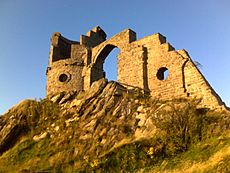
Staffordshire's landscape is quite varied. In the north and south, you'll find hills. The northern part includes the southern end of the Pennines and a section of the Peak District National Park. Most of these northern hills are in the Staffordshire Moorlands district.
In the south, there's Cannock Chase, a beautiful area of natural beauty. Part of the National Forest is also in the south. The middle parts of the county are flatter and gently rolling.
The county has important coalfields and rich iron ore deposits in the south. The main river is the River Trent. The soil is mostly clay, and farming became very important after machines were introduced.
Staffordshire is home to Flash, which is the highest village in Britain. It stands at about 463 meters (1,519 feet) above sea level. The highest point in the county is Cheeks Hill.
Green Areas and Protected Land
Staffordshire has special "green belt" areas. These are protected lands that stop cities from spreading too much. They surround large urban areas like Stoke-on-Trent and the West Midlands. Every district in Staffordshire has some of this protected green land.
Economy and Businesses
Staffordshire is home to many well-known companies. In Burton upon Trent, you'll find major brewing companies like Coors Brewers. This town is also where Marmite is made.
Many famous pottery companies are based in Stoke-on-Trent. These include Michelin Tyres, Royal Doulton, Wedgwood, and Portmeirion Pottery. Steelite International also makes pottery in Middleport.
Bet365, a large online betting company, is one of Stoke-on-Trent's biggest private employers. JCB, a world-famous company that makes construction equipment, is based in Rocester near Uttoxeter.
Other notable companies include Premier Foods, which makes Mr Kipling cakes in Stoke-on-Trent. Numark Pharmacy is in Tamworth. Volkswagen Group (VAG UK) has a large distribution center there.
The county's economy has grown over the years. Many businesses, from manufacturing to services, contribute to its success.
Areas and Towns
Staffordshire is divided into several administrative areas, each with its own main town and smaller settlements.
| Administrative Area | Main Town | Other Towns and Villages | |
|---|---|---|---|
| Cannock Chase District |
 |
Cannock | Hednesford, Rugeley, Norton Canes |
| East Staffordshire |
 |
Burton upon Trent | Uttoxeter, Barton under Needwood, Branston |
| Lichfield District |  |
Lichfield | Burntwood, Fazeley, Alrewas |
| South Staffordshire |  |
Codsall | Brewood, Penkridge, Gailey |
| Newcastle Borough |  |
Newcastle-under-Lyme | Silverdale, Madeley, Keele |
| Stafford |  |
Stafford | Haughton, Stone, Eccleshall |
| Staffordshire Moorlands District |  |
Leek | Alton, Cheadle, Biddulph |
| City of Stoke-on-Trent (unitary authority) |  |
Stoke on Trent | Hanley, Burslem, Tunstall, Longton |
| Tamworth District |  |
Tamworth | Wilnecote, Stonydelph, Glascote |
Historic Towns Now in West Midlands
Some towns that were once part of Staffordshire are now in the West Midlands county. These include:
| West Midlands | Aldridge, Bilston, Bloxwich, Brierley Hill, Brownhills, Coseley, Darlaston, Kingswinford, Rowley Regis, Sedgley, Smethwick, Tipton, Walsall, Wednesbury, Wednesfield, West Bromwich, Willenhall, Wolverhampton |
|---|
Religion in Staffordshire
Staffordshire is home to people of many different faiths. The main religion reported in the 2011 census was Christianity. There are also communities of Muslims, Sikhs, and Hindus.
Churches and Cathedrals
The only cathedral in Staffordshire is Lichfield Cathedral in the city of Lichfield. It is a very old and beautiful building. The Diocese of Lichfield covers most of the county. There are many Church of England churches throughout Staffordshire.
Other Faiths
The Roman Catholic Archdiocese of Birmingham includes Staffordshire. Primitive Methodism was founded in Staffordshire by Hugh Bourne from Stoke-on-Trent. He started outdoor church gatherings.
There is a synagogue in Newcastle-Under-Lyme for the Jewish community. Staffordshire also has several mosques, especially in Stoke-on-Trent and Burton-upon-Trent.
Getting Around Staffordshire (Transport)
Canals
Staffordshire has a large network of canals. These include the Birmingham and Fazeley Canal, Caldon Canal, Coventry Canal, and Trent and Mersey Canal. Canals were very important for moving goods during the Industrial Revolution.
Railways
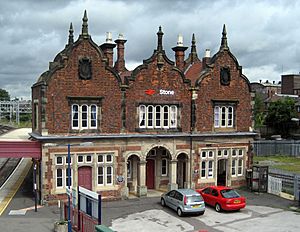
Several railway lines run through Staffordshire. The most important is the West Coast Main Line, which connects London to Scotland. Stafford railway station is a key junction. Stoke-on-Trent railway station is the busiest in the county. It connects to Manchester and Derby.
Roads
Staffordshire has good connections to the national road network. The M6 runs north to south through the county. The M6 Toll, which is a toll motorway, also passes through. Major roads like the A5 and A34 also cross the county.
Airports
There are no major airports with regular flights directly in Staffordshire. The closest large airports are Birmingham, East Midlands, and Manchester. There are smaller airfields for private planes.
Buses
Bus services in Staffordshire are mainly provided by companies like Arriva Midlands and First Potteries. National Express coaches also offer long-distance travel.
Media and News
Newspapers
People in Staffordshire can read several daily newspapers. The Sentinel covers Stoke-on-Trent and nearby areas. The Burton Mail focuses on Burton-upon-Trent. The Express & Star has editions for towns like Tamworth and Lichfield.
Radio Stations
Local BBC radio stations include BBC Radio Stoke and BBC Radio WM. Commercial stations like Hits Radio Staffordshire & Cheshire and Capital Mid-Counties also broadcast here. There are also many community radio stations, such as Moorlands Radio in Leek and Stafford FM in Stafford.
Television
Staffordshire is mainly served by ITV Central and BBC West Midlands television regions. These channels have their studios in Birmingham. The far north of the county sometimes receives signals from ITV Granada and BBC North West.
Famous People from Staffordshire
- George Anson, 1st Baron Anson (1697–1762), a famous admiral
- Philip Astley (1742–1814), known as the "father of the modern circus"
- Joseph Bamford (1916–2001), a successful businessman (founder of JCB)
- Arnold Bennett (1867–1931), a well-known novelist
- Vera Brittain (1893–1970), a writer and advocate for women's rights
- Clarice Cliff (1899–1972), a famous pottery designer
- Samuel Johnson (1709–84), a famous author and dictionary writer
- Lemmy (Kilmister, 1945–2015), a rock musician
- Stanley Matthews (1915–2000), a legendary footballer
- R. J. Mitchell (1895–1937), who designed aircraft (like the Spitfire)
- Neil Morrissey (1962– ), a popular actor
- Edward Smith (1850–1912), captain of the Titanic
- Josiah Spode (1733–97), a famous potter
- Jackie Trent (1940–2015), a singer-songwriter
- Anthea Turner (1960– ), a television presenter
- Josiah Wedgwood (1730–95), a pioneering potter
- Robbie Williams (1974– ), a famous pop singer
Places to Visit
| Key | |
| Owned by the National Trust | |
| Owned by English Heritage | |
| Owned by the Forestry Commission | |
| A Country Park | |
| An Accessible open space | |
| Museum (free) | |
| Museum (charges entry fee) | |
| Heritage railway | |
| Historic House | |
- Alton Towers
 (a popular theme park)
(a popular theme park) - Ancient High House

 (an old house and museum)
(an old house and museum) - Cannock Chase
 (a beautiful area for walking and nature)
(a beautiful area for walking and nature) - Chasewater Railway
 (a heritage railway)
(a heritage railway) - Cheddleton Flint Mill
 (an old mill and museum)
(an old mill and museum) - Churnet Valley Railway
 (another heritage railway)
(another heritage railway) - Drayton Manor Theme Park
 (a fun theme park)
(a fun theme park) - Gladstone Pottery Museum
 (learn about pottery history)
(learn about pottery history) - Lichfield Cathedral
 (a stunning historic cathedral)
(a stunning historic cathedral) - Monkey Forest at Trentham Gardens
 (see monkeys roaming freely)
(see monkeys roaming freely) - Mow Cop Castle
 (a ruined castle with great views)
(a ruined castle with great views) - National Memorial Arboretum (a place to remember those who served)
- Peak District National Park
 (part of a large national park)
(part of a large national park) - Potteries Museum & Art Gallery
 (explore art and local history)
(explore art and local history) - Shugborough Estate
 (a grand historic estate)
(a grand historic estate) - Stafford Castle
 (the remains of a medieval castle)
(the remains of a medieval castle) - Staffordshire Regiment Museum
 (learn about local military history)
(learn about local military history) - Tamworth Castle
 (a historic castle in Tamworth)
(a historic castle in Tamworth) - Trentham Gardens
 (beautiful gardens to explore)
(beautiful gardens to explore) - Tutbury Castle
 (another historic castle)
(another historic castle) - Wall Roman Site

 (remains of a Roman town)
(remains of a Roman town) - Wedgwood Museum
 (discover the history of Wedgwood pottery)
(discover the history of Wedgwood pottery)
Images for kids
See also
 In Spanish: Staffordshire para niños
In Spanish: Staffordshire para niños


